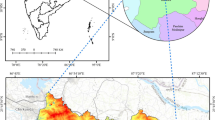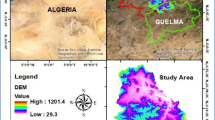Abstract
Assessing land use/cover (LULC) change in coastal lakes is an essential process for sustainable development. Edku Lake is one of the most important lakes in the northern part of Nile Delta in Egypt. It is directly subject to severe anthropogenic activities. The main objectives of this work were to predict LULC changes within Edku Lake area and to develop a pollution sensitivity model using remote sensing data and modern geographical information system (GIS) techniques. Three Landsat images were acquired in 2000, 2011 and 2018. These images were preprocessed, geo-referenced and prepared for further supervised classification using the maximum likelihood classifier. Five LULC classes were found in the area (water, vegetation, urban, bare and fish farm). CA–Markov model was applied to predict LULC changes using IDRISI software between each two consequent years. A predicted LULC map was obtained for 2025. This map can provide suggestions for future urban and vegetative planning in the studied area. This area was subject to severe changes from 2000 to 2018. Fish farms were significantly increased during this period. The predicted LULC map for 2025 indicates that large vegetative areas will be converted into urban and fish farms. The pollution sensitivity model showed that the eastern parts of the lake are more sensitive to pollution compared with the rest of the lake. Accordingly, protection of biodiversity in Edku Lake can be achieved based on future scenarios and measuring sensitivity of environmental factors and surrounding activities.














Similar content being viewed by others
References
Abd El-Hamid, H. T., Hegazy, T. A., Ibrahim, M. S., & El-Moselhy, K. M. (2017). Assessment of water quality of the Northern Delta lakes, Egyptian. Journal of Environmental Sciences, 46(1), 21–34.
Badr, N., & Hussein, M. (2010). An input/output flux model of total phosphorous in Lake Edku, a Northern Eutrophic Nile Delta lake. Global Journal of Environmental Research, 4(2), 64–75.
Basommi, L. P., Guan, Q. F., Cheng, D., & Singh, S. K. (2016). Dynamics of land use change in a mining area: A case study of Nadowli District, Ghana. Journal of Mountain Science, 13(4), 633–642.
Batabyal, A. A., Kahn, J. R., & O’Neill, R. V. (2003). On the scarcity value of ecosystem services. Journal of Environmental Economics and Management, 46(2), 334–352.
Beheira Governorate Subdivisions. (2018). CityPopulation.de. Archived from the original on 2018-11-25. Retrieved November 24, 2018.
Birks, H. H., Birks, H. J. B., Flower, R. J., Peglar, S. M., & Ramdani, M. (2001). Recent ecosystem dynamics in nine North African lakesin the CASSARINA Projects. Aquatic Ecology, 35(3-4), 461–478.
El-Amier, Y. A., El-Alfy, M. A., Haroun, S. A., & Nofal, M. M. (2017). Spatiotemporal assessment of water and sediment quality in Idku Lake, Egypt using multivariate analysis and inverse distance weighting method (GIS Tool). Journal of Environmental Sciences, 46(2), 137–153.
El-Amier, Y. A., El-Alfy, M. A., & Nofal, M. (2018). Macrophytes potential for removal of heavy metals from aquatic ecosystem, Egypt: Using metal accumulation index (MAI). Plant Archives, 18(2), 2134–2144.
El Batrawy, O. A., Abdel Wahaab, R., Ibrahiem, M. S., Soliman, S. S., & Yehia, A. G. (2018). Future perspective for water scarcity challenges in Northern Nile Delta: Desalination opportunities. Middle East Journal of Applied Sciences, 8(04), 1094–1111.
El-Hamid, H. T. A., Caiyong, W., & Yongting, Z. (2019). Geospatial analysis of land use driving force in coal mining area: Case study in Ningdong China. GeoJournal, 78(4). https://doi.org/10.1007/s10708-019-10078-2.
Fang, J., & Liao, Z. D. (2014). Forestry landscape patterns changes and dynamic simulation of Nanling National Nature Reserve, Guangdong. Sciatica Geographic Sinica, 34(9), 1099–1107.
Galicia, L., & Garcia-Romero, A. (2007). Land use and land cover change in highland temperate forests in the Izta-Popo National Park, Central Mexico. Mountain Research and Development, 27(1), 48–57.
Gupta, S., Chabukdhara, M., Kumar, P., Singhand, J., & Bux, F. (2014). Evaluation of ecological risk of metal contamination in river Gomti, India: A biomonitoring approach. Ecotoxicology and Environmental Safety, 110, 49–55.
He, D., Zhou, J., Gao, W., Guo, H. Y. U. S., & Liu, Y. (2014). An integrated CA–markov model for dynamic simulation of land use change in Lake Dianchi watershed. Bei**g Daxue Xuebao (Ziran Kexue Ban)/Acta Scientiarum Naturalium Universitatis Pekinensis, 50(6), 1095–1105.
Hyandye, C., & Martz, L. W. A. (2017). Markov and cellular automata land-use change predictive model of the Usangu Catchment. International Journal of Remote Sensing, 38(1), 64–81.
Jiyuan, L. (1992). Land use in Tibet autonomous region (pp. 1–60). Bei**g: Science Press.
Khalil, M. T. (2018). Physical and chemical properties of Egypt’s Coastal Wetlands; Burullus Wetland as a case study. In A. Negm, M. Bek, & S. Abdel-Fattah (Eds.), Egyptian coastal lakes and wetlands: Part I. The handbook of environmental chemistry (p. 71). Cham: Springer.
Landis, R. J., & Koch, G. G. (1977). The measurement of observer agreement for categorical data. Biometrics, 33(1), 159–174.
Lu, D., Li, G., & Moran, E. (2014). Current situation and needs of change detection techniques. International Journal of Image and Data Fusion, 5(1), 13–38.
Ma, C., Zhang, G. Y., Zhang, X. C., Zhao, Y. J., & Li, H. Y. (2012). Application of Markov model in wetland change dynamics in Tian** Coastal Area, China.The 18th Biennial Conference of International Society for Ecological Modelling. Procedia Environmental Sciences, 13, 252–262.
Mishra, V. N., & Rai, P. K. (2016). A remote sensing aided multi-layer perceptron-Markov chain analysis for land use and land cover change prediction in Patna district (Bihar), India. Arabian Journal of Geosciences, 9(4), 249.
Mustafa, E. K., Liu, G., El-Hamid H. T. A., & Kaloop, M. R. (2019). Simulation of land use dynamics and its impact on land surface temperature in Bei**g using satellite data. GeoJournal, 1–19.
Nguyen, T. A., Le, P. M. T., Pham, T. M., Hoang, H. T. T., Nguyen, M. Q., & Ta, H. Q. (2017). Toward a sustainable city of tomorrow: A hybrid Markov–Cellular automata modeling for urban landscape evolution in the Hanoi city (Vietnam) during 1990–2030. Environment, Development and Sustainability, 21, 429–446. https://doi.org/10.1089/sus.2017.29092.aml
Okbah, M. A., & El-Gohary, S. E. (2002). Physical and chemical characteristics of Edku Lake Water, Egypt. Mediterranean Marine Science, 3(2), 27–39.
Radwan, A. M., Abdelmoneim, M. A., Basiony, A. I., & El-Alfy, M. A. (2019). Water pollution monitoring in Idku Lake (Egypt) using phytoplankton and NSF-WQI. Egyptian Journal of Aquatic Biology & Fisheries, 23(4), 465–481.
Rai, S. C., Sharma, E., & Sundriyal, R. C. (1994). Conservation in the Sikkim Himalaya: Traditional knowledge and land-use of the Mamlay watershed. Environmental Conservation, 21(1), 30–34.
Sheela, A. M., Letha, J., Joseph, S., Ramachandran, K. K., & Justus, J. (2013). Assessment of pollution status of a coastal lake system using satellite imagery. Journal of Geophysics & Remote Sensing, 2(1): 1-11. https://doi.org/10.4172/2169-0049.1000110.
Siam, E., & Ghobrial, M. (2000). Pollution influence on bacterial abundance and chlorophyll-a concentration case study at Idku Lagoon. Scienta Marina, 64(1), 1–8.
Singh, S. K., Laari, P. B., Mustak, S. K., Srivastava, P. K., & Szabó, S. (2018). Modelling of land use land cover change using earth observation data-sets of Tons River Basin, Madhya Pradesh, India. Geocarto International, 33(11), 1202–1222.
Sisi, X., Chunxi, W., & **yu, C. (2012). Analysis of land use change and driving factors in Taihu Lake Region: 1980 to 2005. Journal of Agricultural Engineering, 28(23), 1–2.
Sohl, T. L., & Claggett, P. R. (2013). Clarity versus complexity: Land-use modeling as a practical tool for decision-makers. Journal of Environmental Management, 129, 235–243.
USEPA. (2000). A retrospective assessment of the costs of the clean water act: 1972 to 1997. Washington DC: US Environ. Protection agency contract number 67-W7-0018, 2000.
Verburg, P. H., Neumann, K., & No, L. (2011). Challenges in using land use and land cover data for global change studies: Land use and land cover data for global change studies. Global Change Biology, 17(2), 974.
Voogt, J. A., & Oke, T. R. (2003). Thermal remote sensing of urban climates. Remote Sensing of Environment, 86, 370–384.
Yang, A., & Sun, G. (2017). Landsat-based land cover change in the Bei**g–Tian**–Tangshan urban agglomeration in 1990, 2000 and 2010. ISPRS International Journal of Geo-Information, 6(3), 59.
Zhao, L., & Peng, Z. R. (2012). An agent-based cellular automata model of land use change developed for transportation analysis. Journal of Transport Geography, 25, 35–49.
Author information
Authors and Affiliations
Corresponding author
Ethics declarations
Conflict of interest
The authors declare that they have no conflict of interest.
Additional information
Publisher's Note
Springer Nature remains neutral with regard to jurisdictional claims in published maps and institutional affiliations.
Rights and permissions
About this article
Cite this article
Abd El-Hamid, H.T., El-Alfy, M.A. & Elnaggar, A.A. Prediction of future situation of land use/cover change and modeling sensitivity to pollution in Edku Lake, Egypt based on geospatial analyses. GeoJournal 86, 1895–1913 (2021). https://doi.org/10.1007/s10708-020-10167-7
Published:
Issue Date:
DOI: https://doi.org/10.1007/s10708-020-10167-7




